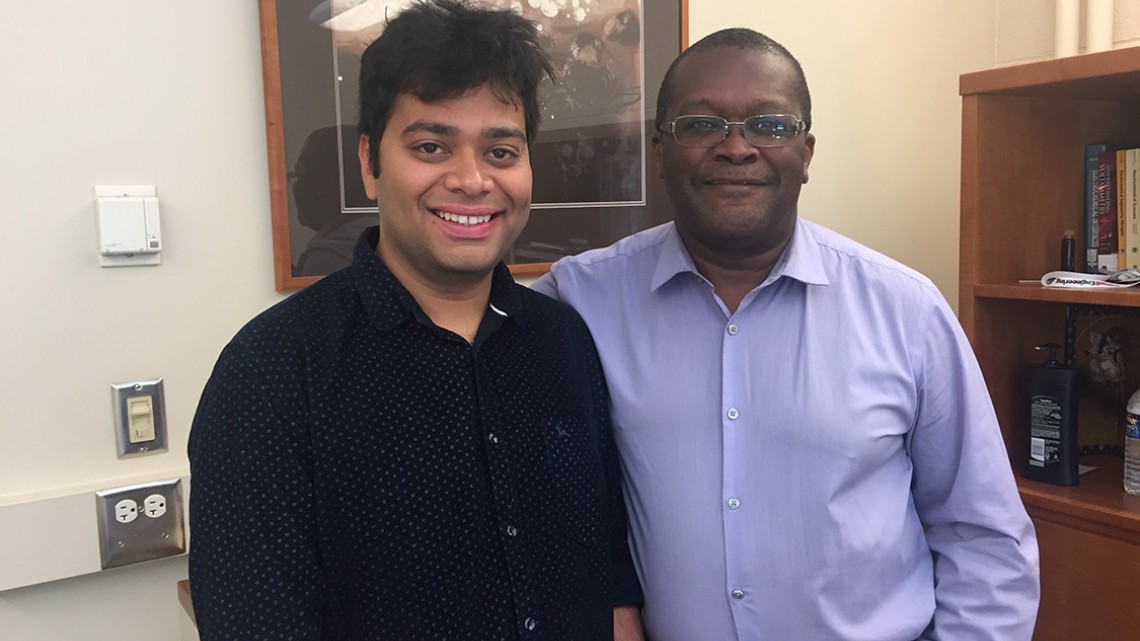
Snehashis Choudhury, Ph.D. '18, left, and Lynden Archer in Archer's Kimball Hall office.
‘Elegant’ design could lead to more powerful, safer lithium metal battery
By Tom Fleischman
Chemical engineering professor Lynden Archer believes there needs to be a battery technology “revolution” – and thinks that his lab has fired one of the first shots.
“What we have now [in lithium-ion battery technology] is actually at the limits of its capabilities,” said Archer, the James A. Friend Family Distinguished Professor of Engineering in the Smith School of Chemical and Biomolecular Engineering. “The lithium-ion battery, which has become the workhorse in powering new electronics technologies, operates at over 90 percent of its theoretical storage capacity. Minor engineering tweaks may lead to better batteries with more storage, but this is not a long-term solution.
“You need a kind of radical mindset change,” he said, “and that means that you’ve got to almost start at the beginning.”
Snehashis “Sne” Choudhury, Ph.D. ’18, has come up with what Archer terms an “elegant” solution to a fundamental problem with rechargeable batteries that use energy-dense metallic lithium anodes: sometimes-catastrophic instability due to dendrites, which are spines of lithium that grow from the anode as ions travel back and forth through the electrolyte during charge and discharge cycles.
If the dendrite breaks through the separator and reaches the cathode, short-circuiting and fire can occur. Solid electrolytes have been shown to suppress dendrite growth mechanically, but at the expense of fast ion transport. Choudhury’s solution: Confine dendrite growth by the structure of the electrolyte itself, which can be controlled chemically.
Using a reaction procedure the Archer group introduced in 2015, they employ “cross-linked hairy nanoparticles” – a graft of silica nanoparticles and a functionalized polymer (polypropylene oxide) – to create a porous electrolyte that effectively lengthens the route ions must take to travel from the anode to the cathode and back, dramatically increasing the life of the anode.
Their paper, “Confining Electrodeposition of Metals in Structured Electrolytes,” was published June 11 in Proceedings of the National Academy of Sciences. Choudhury and Dylan Vu – a rising junior majoring in chemical engineering – are co-first authors.
“Imagine being in a maze, where at every juncture you encounter a roadblock,” Archer said. “In energy storage, the goal is to pack as much energy into the smallest space possible to minimize overall device size. And so one can’t really have long separation distances between components in an absolute sense, but we’ve shown that increasing length scales by introducing tortuous transport pathways is possible.”
Choudhury, who is headed to Stanford University for his postdoctoral work, also devised a method for direct visualization of the inner workings of their experimental battery. The group confirmed theoretical predictions about dendrite growth with Choudhury’s device.
“This is something I’ve wanted to do for, I guess, three Ph.D. students’ lifetimes,” said Archer, who’s been at Cornell since 2000, with a laugh. “What Sne was able to do was design a cell that allowed us to, very elegantly, visualize what is occurring at the lithium-metal interface, giving us now the ability to go beyond theoretical predictions.”
Another novelty of this work, Archer said, is “overturning something of a canon” in battery science. It’s long been held that, in order to suppress dendrite growth, the separator inside the battery must be stronger than the metal it is trying to suppress, but Choudhury’s porous polymer separator – with average pore sizes below 500 nanometers – were shown to arrest the growth.
“Even if one designs a softer separator, but with nanostructuring that creates tortuousness, you can get there,” Archer said. “Part of what we tried to do was to balance the desire to create technologically relevant systems with the desire to understand things fundamentally. If you do that, you are able to design new systems.”
That one of the co-authors – Vu – is an undergraduate is not unusual at Cornell in general and his group in particular, Archer said.
“That’s been a priority, to basically add value to the undergraduate experience by exposing them to research,” he said. “That’s a lot easier said than done, because undergrads aren’t generally here for research. … And Sne has managed, in a sort of miraculous way, to write a paper of this quality with every undergraduate he’s worked with.”
Mukul Tikekar, Ph.D. ’17, and doctoral students Alexander Warren and Zhengyuan Tu also contributed to this work, which was supported by a grant from the National Science Foundation.
Media Contact
Get Cornell news delivered right to your inbox.
Subscribe
